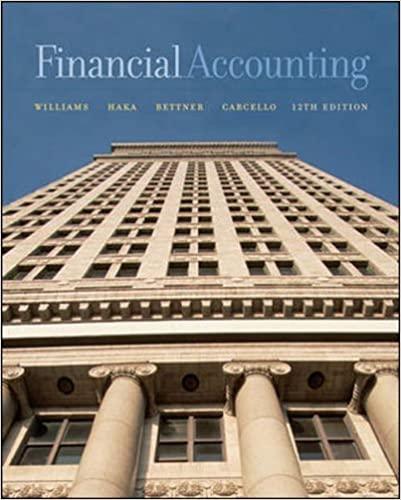Question
Fantastic Props, Inc., designs and fabricates movie props such as mock-ups of star-fighters and cybernetic robots. The companys balance sheet as of January 1, the
| Fantastic Props, Inc., designs and fabricates movie props such as mock-ups of star-fighters and cybernetic robots. The companys balance sheet as of January 1, the beginning of the current year, appears below: |
| Fantastic Props, Inc. Balance Sheet January 1 | ||
| Assets | ||
| Current assets: | ||
| Cash | $13,000 | |
| Accounts receivable | 45,000 | |
| Inventories: | ||
| Raw materials | $36,000 | |
| Work in process | 31,000 | |
| Finished goods (props awaiting shipment) | 51,000 | 118,000 |
| Prepaid insurance | 5,300 | |
| Total current assets | 181,300 | |
| Buildings and equipment | 550,000 | |
| Less accumulated depreciation | 240,000 | 310,000 |
| Total assets | $491,300 | |
| Liabilities and Stockholders' Equity | ||
| Accounts payable | $74,000 | |
| Common stock | $210,000 | |
| Retained earnings | 207,300 | 417,300 |
| Total liabilities and stockholders' equity | $491,300 | |
| Because each prop is a unique design and may require anything from a few hours to a month or more to complete, Fantastic Props uses a job-order costing system. Overhead in the fabrication shop is charged to props on the basis of direct labor cost. The companys predetermined overhead rate for the year is based on a cost formula that estimated $153,000 in manufacturing overhead for an estimated allocation base of $170,000 direct labor dollars. The following transactions were recorded during the year: |
| a. | Raw materials, such as wood, paints, and metal sheeting, were purchased on account, $86,000. | |
| b. | Raw materials were issued to production, $93,000; $5,200 of this amount was for indirect materials. | |
| c. | Payroll costs incurred and paid: direct labor, $121,000; indirect labor, $47,200; and selling and administrative salaries, $68,000. | |
| d. | Fabrication shop utilities costs incurred, $13,000. | |
| e. | Depreciation recorded for the year, $23,000 ($4,100 on selling and administrative assets; $18,900 on fabrication shop assets). | |
| f. | Prepaid insurance expired, $4,100 ($3,500 related to fabrication shop operations, and $600 related to selling and administrative activities). | |
| g. | Shipping expenses incurred, $43,000. | |
| h. | Other manufacturing overhead costs incurred, $17,800 (credit Accounts Payable). | |
| i. | Manufacturing overhead was applied to production. Overhead is applied on the basis of direct labor cost. | |
| j. | Movie props that cost $284,000 to produce according to their job cost sheets were completed. | |
| k. | Sales for the year totaled $470,000 and were all on account. The total cost to produce these movie props was $250,000 according to their job cost sheets. | |
| l. | Collections on account from customers, $430,000. | |
| m. | Payments on account to suppliers, $143,000. |
| Required: | ||
| 1&2. | Prepare a T-account for each account on the companys balance sheet, and enter the beginning balances. Make an entry directly into the T-accounts for transactions (a) through (m). Determine an ending balance for each T-account. (Record the transactions in the given order. Round your intermediate calculations to 2 decimal places.)
3-a.Was manufacturing overhead underapplied or overapplied for the year? (Input the amount as a positive value. Round your intermediate calculations to 2 decimal places.)
| |
Step by Step Solution
There are 3 Steps involved in it
Step: 1

Get Instant Access to Expert-Tailored Solutions
See step-by-step solutions with expert insights and AI powered tools for academic success
Step: 2

Step: 3

Ace Your Homework with AI
Get the answers you need in no time with our AI-driven, step-by-step assistance
Get Started


